Blackjack: How to Play, When to Hit, Split, Surrender & More
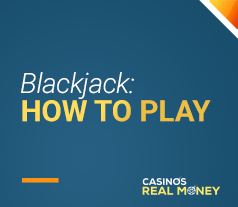
It is not an accident that blackjack has more players than all the other table games combined, including roulette, craps, and baccarat. Blackjack is a game that is based mostly on chance and luck, but it is also a game that requires skill and strategy. That said, it’s more sophisticated than your average game of cards.
The game’s action is exciting, the rules are straightforward, and there is room for advanced strategy. Due to its smaller house edge, blackjack is one of the most enticing casino games to players of all skill levels, from beginners to those who consistently play well.
Do you have what it takes to get the ball rolling? Well, blackjack can be mastered fast and easily. Once you get started you may find yourself playing for hours on end. In this guide, we are going to help you get started by giving you all the details you need.
How Blackjack Works
To get things started, let’s speak about the way the game is laid up. Blackjack is a game in which players compete against the house by playing against the dealer with one or more hands. At any given table, there could be one player, or there might be many. The game makes use of numerous decks to reduce the amount of time required for shuffling.
This can be as little as 2 decks or as many as 8 decks of cards.
To begin the game of blackjack, each player is dealt two cards face up. Both the player and the dealer are dealt two cards; however, one of the dealer’s cards is face down. The dealer is responsible for operating the game in its entirety, from reshuffling and dealing the cards to managing all the bets and wagers.
As a player, the goal is always to beat the dealer.
This means achieving a total point score of 21 or as near to it as possible. If the total value of your cards is greater than the entire value of the dealer’s cards without going over 21, you win the hand.
Players have the choice of hitting, standing, doubling down, or splitting pairs. When everyone at the table has had their turn and is pleased with their hand or goes bust, the dealer will reveal the card that was dealt face-down. If your hand total exceeds 21, you are said to “bust,” and you will automatically lose your bet. In the event that the dealer goes bust, the player gets to win the hand.
Blackjack Basic Strategy
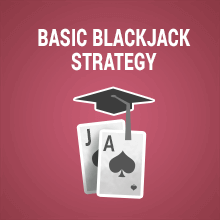
The basic strategy was formed by simulating a blackjack game on a computer.
A blackjack-playing computer played hundreds of millions of hands and the outcomes of those actions were recorded. To find the best probable outcomes for each player’s starting hand and dealer ‘up’ card combination, the computer algorithm went through a trial-and-error process.
With this in mind, the basic blackjack strategy enables players to make the best decisions possible at any given moment. When it is put into practice, players get the greatest potential RTP, which, to put it another way, reduces the advantage the house has over them. Since it is the product of a computer algorithm, this method is completely free of bias. That is because relies only on the application of mathematical principles in its decision-making.
Blackjack Hit Chart
Know exactly when to hit in blackjack, when to split, when to double down in blackjack and what to do in every conceivable hand, using the ‘Blackjack: When to Hit’ chart below:
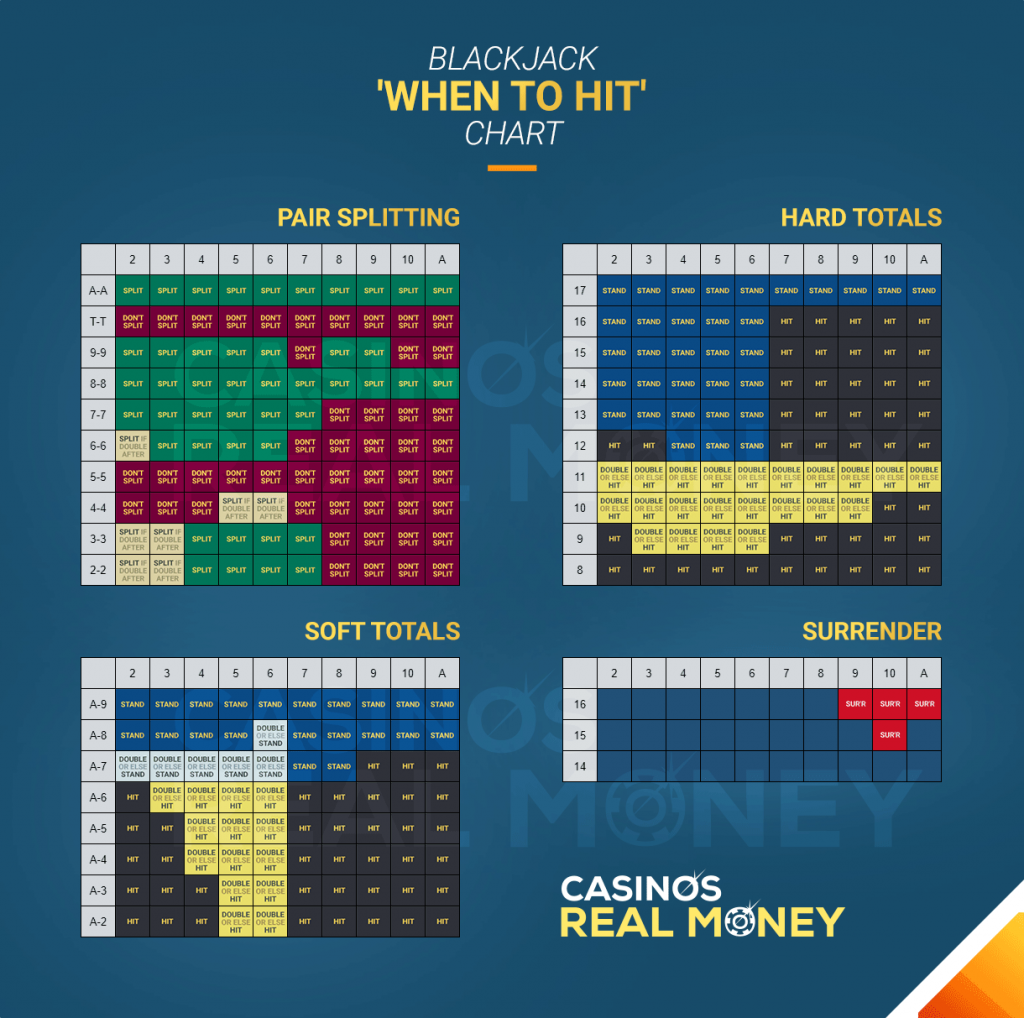
Click here to download the Blackjack Hitting Chart (108kb)

Tap here to download the Blackjack Hitting Chart (178kb)
The Blackjack ‘hit or stand’ chart above provides instructions about what to do in every conceivable circumstance. After you have mastered the technique for using these charts, there is nothing else you need to keep in your memory.
So, what are some of the decisions that these charts can help you make?
We’ll explore them below…
When to Hit in Blackjack
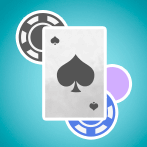
If you have a hand with a low value and the dealer’s card has a high value, you should most of the time try to ‘hit’ – that is, to request an additional card. When you have 9-11 against any of the dealer’s cards, you have the option to hit as well. You should consider doubling down even if you have an Ace in your hand.
Blackjack Split Rules: When to Split in Blackjack
There are many rules for splitting in blackjack depending on the variation of the game you are playing. However, in most cases, the best options to warm up your ‘split blackjack’ skills according to our strategy charts are as follows:
- Always split aces.
- Never split tens.
- If you have a pair of nines, you may split your hand against the dealer’s 2 through 9 (with the exception of 7); otherwise, you should stand.
- Always split 8’s
- A pair of 7s splits against the dealer’s 2 through 7 if the dealer has 2 through 7; else, hit.
- A pair of 6s splits against the dealer’s 2 through 6 if the dealer has 2 through 6; else, hit.
- If you have a pair of fives, you may double down against the dealer’s 2 through 9; otherwise, hit.
- If you have a pair of 4, you may split against the dealer’s 5 and 6, but you must hit any other hands.
- A pair of threes splits against the dealer’s 2 through 7 if the dealer has 2 through 7; else, hit.
- A pair of 2’s splits against the dealer’s 2 through 7 if the dealer has 2 through 7; else, hit.
When to Stand in Blackjack
When the dealer’s upcard is 17-20, you should stand. You should fold if the dealer has a bust card, and let them bust if they have a lower hand. If the dealer, on the other hand, has a high card, busting out does not help you at all anyway.
If the dealer has bust cards and you have a hard 13-16, standing is also recommended in this situation. The odds in blackjack indicate that the dealer has a greater chance of busting. Instead, take a lesser hand and gain the benefits of playing wisely throughout the game.
You can save yourself the trouble of having to remember all of this by downloading the strategy chart image above and studying it. Save them on your computer or phone, or print them out if needed.
Does it get any easier than that?
Is Blackjack Luck or Skill?
Winning in blackjack is generally a combination of strategy and luck. While the former is critical to achieving victory, many casual gamers barely pay attention to it. It is all about getting lucky for them.
However, putting all your eggs in one basket and counting on luck to come through for you every time will not provide the outcomes you are looking for.
This is especially true if you are playing to win some money.
Blackjack forces players to make a series of choices that may significantly alter the outcome of the game. At the very least, you must decide on whether you will hit, stand, or double down. The application of a strategy may go a long way toward helping you acquire an advantage over both the casino and the other players.
A basic strategy is an excellent place to get started until you’re ready for some more advanced strategy to supplement your knowledge. You won’t have any trouble figuring out how to utilize most of them, and doing so will get you closer to choosing a course of action.
The ability to count courts in blackjack is a more useful talent though it might seem harder to master. However, that is not where the story ends. At the blackjack tables, players have discovered methods to get an advantage by using advanced strategies in certain situations.
Advanced Blackjack Strategy

If you are a regular blackjack player and want to win practically every time, you should be acquainted with several advanced blackjack strategy approaches. These are not typically included in the basic strategy. Players need a firm knowledge of advanced blackjack strategy to master the game and play like seasoned professionals.
Players have the option of incorporating any one of a wide variety of play strategies into their gameplay. These strategies comprise some of the most complicated blackjack tips that players may use as a guide for how they should play each round to beat the casino. The good news is that even experienced players may use these strategies to increase their chances of winning.
A few of the popular strategies we would recommend to our readers are as follows:
‘No Bust’ Strategy
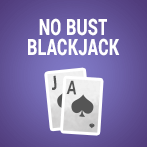
In this strategy, if a player possesses blackjack ‘bust cards’ (also known as a hand value between 12 and 16), they should never fold and should always stay with the expectation that the dealer will bust. Because the player is still in the game, even if the dealer hits and busts, the player will still win the hand.
Even if the dealer has a powerful seven-through-ace hand, the player is advised not to take a hit. This tactic may be appealing to individuals who are prone to nervous dispositions, but it does not provide much in the way of excitement. That said, it should only be used when one is confident about the potential outcomes be it good or bad.
Insurance in Blackjack
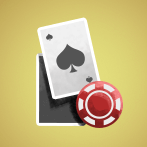
When you place an insurance bet, you are taking a safety measure against the dealer holding Blackjack. An insurance bet may only be placed if the dealer’s upcard is an Ace. The insurance time expires when the dealer’s second card is revealed.
In most cases, the insurance side bet pays out 2:1 and is played independently of the primary wager. The player receives a payout of $2 for each $1 stake in the insurance bet if the dealer’s hole card totals 10, resulting in a blackjack. Insurance bet losses are forfeited in case the dealer does not win the hand and normal play continues.
Blackjack insurance could cost you money in the long run.
Because of this, you want to make sure that you only use it when absolutely required.
What Does ‘Double Down’ Mean in Blackjack?
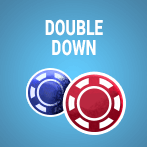
A blackjack ‘double down’ means doubling your stake in the middle of a hand, after which you are only dealt one more card. Because you can’t strike again and run the danger of losing twice as many chips if you’re given a bad card, it is quite risky.
It is critical to know when to double down.
For the most part, three situations warrant a blackjack double-down wager. These are:
- If you have a hard nine and the dealer’s face-up card is a two-six.
- When the dealer’s face-up card is a lower number and you hold a hard 10 or 11.
- When you have a soft 16, 17, or 18, and the dealer’s face-up card is a 2.
Under no circumstances should you “play double down blackjack” if the dealer is flashing an ace. You should also avoid doubling down if you’re displaying an 11 or above since the danger of going bust is just too great.
What Is ‘Surrender’ in Blackjack?
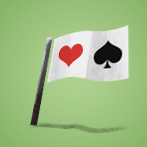
A blackjack ‘Surrender’ is an option in a game that allows the player to give up their hand before drawing fresh cards. Half of the initial stake is restored to the stack and half is lost to the dealer when a player decides to do this.
So, what is ‘early surrender‘ in blackjack?
During the gameplay, you may give up your hand early, before the dealer has checked to see whether he has any blackjacks, or after the dealer has checked which would be considered a ‘late surrender‘.
It’s easy to become lost in the maze of surrender possibilities when you’re just learning the game of blackjack. Unless you’re an experienced player, the little advantage you obtain from the difficulty bump is not worth it. Despite this, by knowing when to surrender Blackjack games with any bankroll can go much further in the long run, so it’s worth at least learning some possibilities to give yourself an opportunity to get out of a sticky situation and limit the amount of money you lose even when the odds are stacked against you.
Test your skills with our list of recommended casinos for specifically playing real money Blackjack on when you’re ready. Remember to keep that Blackjack ‘hit or stand’ chart above handy with you when you do!



